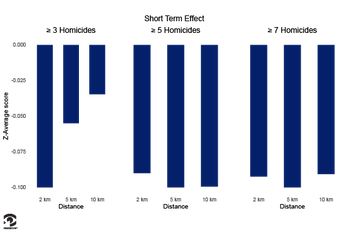This blog is a part of our series, "Perspectives in Crime" where we explore leading academic studies that touch on crime data.
A growing body of academic literature explores the impacts of local violence on academic performance, working to shed light on the collateral damage violent crime wreaks across communities.
In 2006, six major drug cartels were active across more than two-thirds of Mexico’s municipalities. That same year, President Felipe Calderen was elected and declared a “war on drugs” tasking the military with the disruption of trafficking and arrest of drug cartel leaders. The ensuing arrests and impact on the drug trade produced turf wars and escalating violence. The drug war spurred a variety of violent criminal activity, including murders, kidnapping, torture, and the trafficking of weapons and humans. The violence targeted both members of drug cartels but also local politicians, journalists, and the police and military.
Mexico’s surge of violence
A 2020 paper, “Violence, psychological stress and educational performance during the ‘war on drugs’ in Mexico” by Maren M. Michaelsen and Paola Salardi published by the Journal of Development Economics, utilizes local homicide records and standardized test results to analyze Mexico’s surge of violence from 2006 to 2011 and the impact it had on students.
The study years encapsulate a crime surge in Mexico attributed largely to the violent conflict between warring drug cartels and authorities. Researchers used total homicides from official government statistics, victimization reports and media coverage to understand the scale of violence and develop a geographic understanding of where violence occurred. While these numbers capture some homicides not related to the drug trade, the overall spike in violence is generally attributed to cartel violence. During the study period, Mexico’s homicide rate grew from 7.8 per 100,000 people in 2007 to 22.5 per 100,000 in 2011. The dataset provided Michaelsen and Salardi with detailed geographic information regarding each homicide, which they used to locate the closest primary schools.
Figure 1 shows the extreme increase in homicides via data compiled by researchers.

The widespread nature of this violence produced fear, anxiety, and psychological stress across communities. It was the specific goal of researchers to analyze this psychological stress, an invisible collateral cost of violence, and the specific implications of this violence on children. Negative effects on students learning and academic performance can have longstanding impacts on graduation rates and future earnings.
Homicides and school location
Michaelsen and Salardi used test scores in Spanish and Math from the national standardized exam ENLACE (Evaluacion Nacional del Logro Academico en Centros Escolares) as a measurement of aggregate student performance. They set out to measure both the short- and long-term effect of local homicides on student performance. This entailed measurement and analysis on the impacts of nearby violence that had occurred the week before exams as well as the cumulative effects of homicides over the course of the nine-month school year leading up to exams. Precise data on homicide and school location enabled researchers to map the occurrence of homicides located within 2 km, 5 km, and 10 km of individual schools. Data included approximately 18,000 public primary schools across 1,300 Mexican municipalities.
Researchers found that on average, over the nine-month school year, sample schools were exposed to roughly 15 homicides within a 2 km radius, roughly 30 homicides within a 5 km radius, and about 58 homicides within a 10 km radius.
Researchers found a clear and significant relationship between violence and faltering student performance. For schools experiencing at least 3 homicides within a 2 km radius directly preceding exams, the average exam score was roughly 4.4 points lower. Over 9% of schools in the sample experienced three or more homicides within a 2 km radius in the week leading up to an exam. Importantly, the study also found that nearby homicide in the week prior to the exam appeared to have an effect 30 times larger than a homicide occurring earlier in the school year.
Figure 1 below demonstrates the short-term effect of homicides in the week leading up to the exam on Z-average scores for student exam takers after controlling for school fixed effects.

Researchers analyzed the impact of violence on both the Spanish and Math portions of the tests and found a larger impact on math scores, potentially due to the opportunity for more “flexible grading” within language assessments. The strongest impacts were on younger students, which Michaelsen and Salardi felt supported their hypothesis of psychological stress, as younger students were more likely to be unconsciously impacted by local violence, responding to changes in parent and community behavior.
Long-term effects of local homicides
Turning to the long-term effects, the study found a correlation between diminished performance and schools exposed to many homicides, though a smaller effect relative to more recent homicides. During a typical school year, schools exposed to at least 100 homicides within a 2 km radius had exam scores that averaged 3.5 points lower.
Both the short-term and long-term effects that violence has on academic performance emphasize continued findings that crime reaches further into communities than its direct victims. Conflicts oriented around the drug trade have been a significant driver of violence across Mexico, and unfortunately this research demonstrates the capacity for lasting effects of community violence.
Source:
Michaelsen, Maren M., Salardi, Paola. “Violence, psychological stress and educational performance during the “war or drugs” in Mexico. Journal of Development Economics 143 (2020) 102387.





